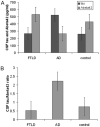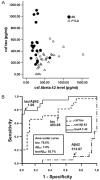CSF biomarkers in frontotemporal lobar degeneration with known pathology
- PMID: 18458217
- PMCID: PMC2707002
- DOI: 10.1212/01.wnl.0000311445.21321.fc
CSF biomarkers in frontotemporal lobar degeneration with known pathology
Abstract
Objective: To evaluate the diagnostic value of CSF biomarkers in patients with known pathology due to frontotemporal lobar degeneration (FTLD).
Background: It is important to distinguish FTLD from other neurodegenerative diseases like Alzheimer disease (AD), but this may be difficult clinically because of atypical presentations.
Methods: Patients with FTLD (n = 30) and AD (n = 19) were identified at autopsy or on the basis of genetic testing at University of Pennsylvania and Erasmus University Medical Center. CSF was obtained during a diagnostic lumbar puncture and was analyzed using assays for total tau and amyloid-beta 1-42 (A beta(42)). Patients also were assessed with a brief neuropsychological battery.
Results: CSF total tau level and the ratio of CSF total tau to A beta(42) (tau/A beta(42)) were significantly lower in FTLD than in AD. Receiver operating characteristic curve analyses confirmed that the CSF tau/A beta(42) ratio is sensitive and specific at discriminating between FTLD and AD, and is more successful at this than CSF total tau alone. Although some neuropsychological measures are significantly different in autopsy-proven FTLD and AD, combining these neuropsychological measures with CSF biomarkers did not improve the ability to distinguish FTLD from AD.
Conclusions: The ratio of CSF tau/A beta(42) is a sensitive and specific biomarker at discriminating frontotemporal lobar degeneration from Alzheimer disease in patients with known pathology.
Figures


References
-
- Hutton M, Lendon CL, Rizzu P, et al. Association of missense and 5′-splice-site mutations in tau with the inherited dementia FTDP-17. Nature. 1998;393:702–705. - PubMed
-
- Poorkaj P, Bird TD, Wijsman E, et al. Tau is a candidate gene for chromosome 17 frontotemporal dementia. Ann Neurol. 1998;43:815–825. - PubMed
-
- Rademakers R, Cruts M, van Broeckhoven C. The role of tau (MAPT) in frontotemporal dementia and related tauopathies. Hum Mutat. 2004;24:277–295. - PubMed
-
- Ghetti B, Hutton ML, Wszolek ZK. Frontotemporal dementia and parkinsonism linked to chromosome 17 associated with Tau gene mutations (FTDP-17T) In: Dickson D, editor. Neurodegeneration: the molecular pathology of dementia and movement disorders. ISN Neuropath Press; Basel, Switzerland: 2003. pp. 86–102.
Publication types
MeSH terms
Substances
Grants and funding
LinkOut - more resources
Full Text Sources
Other Literature Sources
Medical
